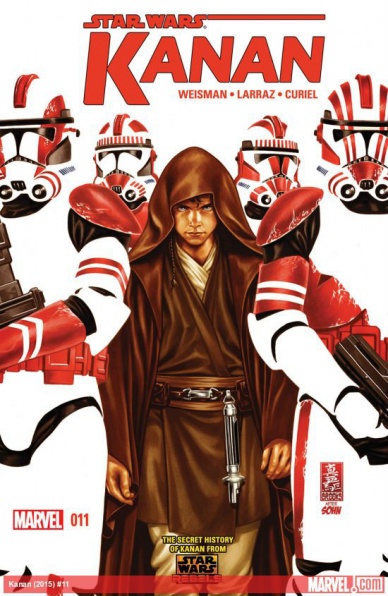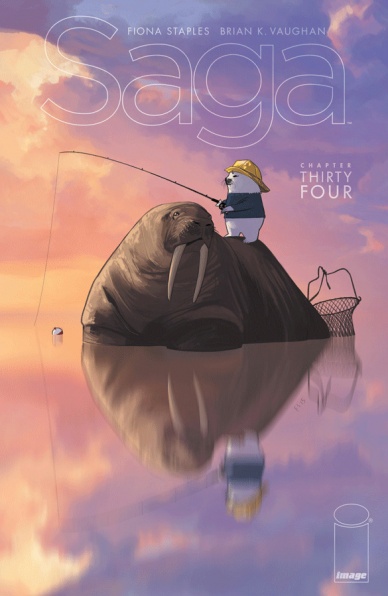There is a lot to cover on Wednesdays. We should know, as collectively, we read an insane amount of comics. Even with a large review staff, it’s hard to get to everything. With that in mind, we’re back with Wrapping Wednesday, where we look at some of the books we missed in what was another great week of comics.
Let’s get this party started.

“Dark Knight III: The Master Race” #3
Written by Frank Miller and Brian Azzarello
Illustrated by Adam Kubert, Klaus Jansen, and John Romita Jr
Reviewed by Stephenson Ardern-Sodje
Miller and co’s latest foray into the world of the Dark Knight takes a polarising and politically charged turn.
While the first couple of issues of “DKIII” managed to strongly reestablish the tone and world of Miller’s Dark Knight, issue three is an all out action packed event, barrelling forward with a story that is all about the shock and awe. Miller and Azzarello’s freshly freed Kryptonians are on a warpath that reads with heavy shades of religious extremism, complete with members of Quar’s cult becoming living bombs. There are strong strokes of Miller’s more questionable previous work — “Holy Terror” — in the less than nuanced way that the Kryptonians are portrayed here, but there’s a surprising amount of softness in his latest rendering of Batman. Bruce as an ageing bruiser makes his debut in a book about his legacy, and there are some seriously touching moments between him and protégé Carrie that serve to show a much more caring side of his personality than we’ve seen in other versions of his older self.
Kubert and Jansen are still doing a great job of uniting the visuals of the entire franchise, channelling Miller’s original thick, heavy linework and crowded panelling. This issue sees a lot of action take place, and there’s a strong sense of bombastic flair to their ranting Quar that contrasts nicely with Bruce’s hulking stoicism. Still, its the quieter moments in this issue that bring it to life for me. Bruce and Carrie share an instance of paternal stillness that helps remind us of the relentless nature of heroism, while a mirrored moment between Lana and a new potential father figure is made to feel visually similar just through the touch of a hand.
JRJ’s additional material for Green Lantern’s supporting story feels a little more slapdash, with certain panels feeling almost unfinished. There’s a larger story being built in the back of “DKIII”s issues, but this supplementary piece doesn’t do much except add to the enigmatic and violently righteous Kryptonian mythos. Miller’s trademark political storytelling is clearly on full display in “DKIII”, but if the book continues down this path it runs the risk of reading less like well informed fiction and more like a Millerian manifesto.
Final Verdict: 6.6 – As the action begins in earnest its going to be interesting to see where this book goes from here.

Kanan #11
Written by Greg Weisman
Illustrated by Pepe Larraz
Review by Ken Godberson III
With the penultimate issue to the series, Greg Weisman, Pepe Larraz and colorist David Curiel wrap up you Caleb Dume’s first battle in the Clone Wars in grand Star Wars fashion: lots of laser sword action. This issue is very much Larraz and Curiel’s show as they depict the fight between Caleb’s master, Depa Billaba and General Grievous, as well as Caleb’s own battle with the enemy and his emotions. A lot of double-page splashes take up the combat, allowing the art’s already cartoony style be a bit more fluid. Curiel’s colors have always been a great fit for the Star Wars-verse, perhaps on par with Ponsor’s over on the main title. They’re unapologetically bold, emphasizing both the triumphs and tragedies in Caleb’s life and when he grows into Kanan Jarrus. Larraz and Curiel conclude their action showcase with a revitalized Kanan being able to cut loose and it feels great, providing even a bit of fanservice (What? Kanan’s a lovely looking dude.)
Weisman concludes the opening chapter of Caleb Dume’s story in a very well with the exception of feeling slightly rushed. Caleb touches on how easy he could give in to his rage after seeing one of his comrades but how, in the end, it would do nothing to honor his fallen comrade. Weisman even delves into the fact that, yeah Caleb is technically a child soldier and how he really no longer feels like a kid. Knowing the tragedies to come, it makes it all the more heartbreaking.
Continued belowFinal Verdict: 8.1- While it could have done with one more issue, Weisman, Larraz and Curiel provide a really good conclusion to Caleb Dume’s baptisim by fire.

Plutona #4
Written by Jeff Lemire
Illustrated by Emi Lenox and Jordie Bellaire
Reviewed by Matthew Garcia
“Plutona” has developed in ways I totally hadn’t expected. Instead of taking the Stand By Me coming-of-age everyone-grows-to-know-each-other-better adventure, Jeff Lemire and Emi Lenox have taken it down a more disparate path: namely watching as these kids come unhinged at dealing with this whole ordeal. In the penultimate chapter, the kids’ relationships are strained to the point of breaking, and it’s almost inevitable no one is going to come out of this in a good place.
Lenox and Lemire have done an admirable job at controlling the tone and atmosphere of the book. Lemire’s script is brisk but effective, telling so much with the just right set of scenes And only a small amount of dialogue. Each scene plays off the previous as it quietly unravels these questions. Big moments like the last page revelation have a stronger impact. Lenox, meanwhile, delivers so much through simple gestures. Her cartooning allows for exaggerated expressions and movements, but she never presses too hard to take us out of the world. She likes bigger panels that allow her to play with the negative space and help us understand all the better the isolation and dislocation these kids are dealing with.
By staying consistent and calm and allowing the tension to build while staying true to the characters, Jeff Lemire and Emi Lenox have turned in what’s shaping to be a heartbreaking and emotionally wrought story. While the book itself isn’t loud, the whole thing speaks enormously.
Final Verdict: 8.0 – Lemire and Lenox have a strong collaboration; now we just have to wait to see if they land the ending.

Nowhere Men #8
Written by Eric Stephenson
Illustrated by Dave Taylor and Emi Lenox
Reviewed by Michelle White
I don’t know if I bumped my head too many times this year or what, but I’m losing patience with dense, expositional stories. Creating an intricate universe is one thing; keeping the readers oriented and engaged is another, and not every creator has the chops to keep a story cohesive. It’s a testament to the sheer talent of this team that, despite the multimedia approach, the large cast of characters, and a change of artists between arcs, there’s no getting lost in the world of “Nowhere Men”.
As our team of quarantined scientists (virus-infected, and consequently transformed) learns more about their situation, there’s a lot of character development going on between the lines. In explaining – and smoothing over – the details of their current arrangement, superstar scientist Dade Ellis comes through with humanizing depth. His charismatic way of speaking is undercut nicely by Monica and Kurt’s real talk, but he maintains an aura of mystery that promises there’s more to be learned here.
It’s definitely a talky issue – hell, they’ve all been talky issues – but Dave Taylor’s work grounds the exposition, keeping to simple compositions during the dense scenes. Most importantly, the expressions are on point at every moment; you’re never in any doubt as to what a character is feeling. When it’s time for sprawling landscapes and twisted wreckage, though, Taylor strikes a balance between science fictional detail and a clean overall aesthetic. And I don’t think I need to tell you at this point that Jordie Bellaire’s colours make it all sing.
Emi Lenox’s segment is peppy and refreshing, mixing up the feel of the comic just as her section did last issue. I hope we keep hearing from Monica’s younger self throughout the arc; in the midst of the maneuvering and self-aggrandizing of the older generation, it’s like being hit with an exuberant BOOM! Box title.
It’s a lot to take in, of course. But the closer you pay attention, the more emotional resonance you find, and with Dave Taylor’s concise storytelling and Fonografiks’ exuberant design, it’s eye candy all the way. The long-awaited second arc of this series is still finding its pace, but it’s adding up to something, slowly but surely.
Continued belowFinal Verdict: 8.5 – It’s still “Nowhere Men”, and it’s still great.

Saga #34
Written by Brian K. Vaughan
Illustrated by Fiona Staples
Reviewed by Jess Camacho
By this point, you’re either reading “Saga” or you’re purposely missing out the best long form storytelling in comic books right now. At 34 issues, “Saga” is still doing some very good things, but like all stories playing the long game, not every issue is a game changer. “Saga” #34 is very much scattered. It follows a few different plots happening but they are thankfully all starting together. Vaughan’s script is dense in the sense that he is juggling a lot of things but the pace is great. Hazel, as predicted, has really become a well formed character and that’s no more apparent than in this issue in the wake of her teacher finding out about what she is. Hazel’s voice is still growing but she’s defined. Her child-like honesty is a ton of fun while still being sort of uncomfortable in the way that all kids can be.
Fiona Staples continues to do great things and shake up comic book art. Her panels are full of rich character designs, expressive, emotional characters and even better set designs. The scope of some scenes is something most artists can’t do. The facility Hazel is living in is massive in it’s dimensions and while it’s meant to be a generic appearing prison, Staples brings her own touches to it through the sleek color work and the smaller details like puddles in the corners and slight cracks in the wall.
Final Verdict: 7.8 – Not the most mind blowing issue but it moves things along very nicely.






